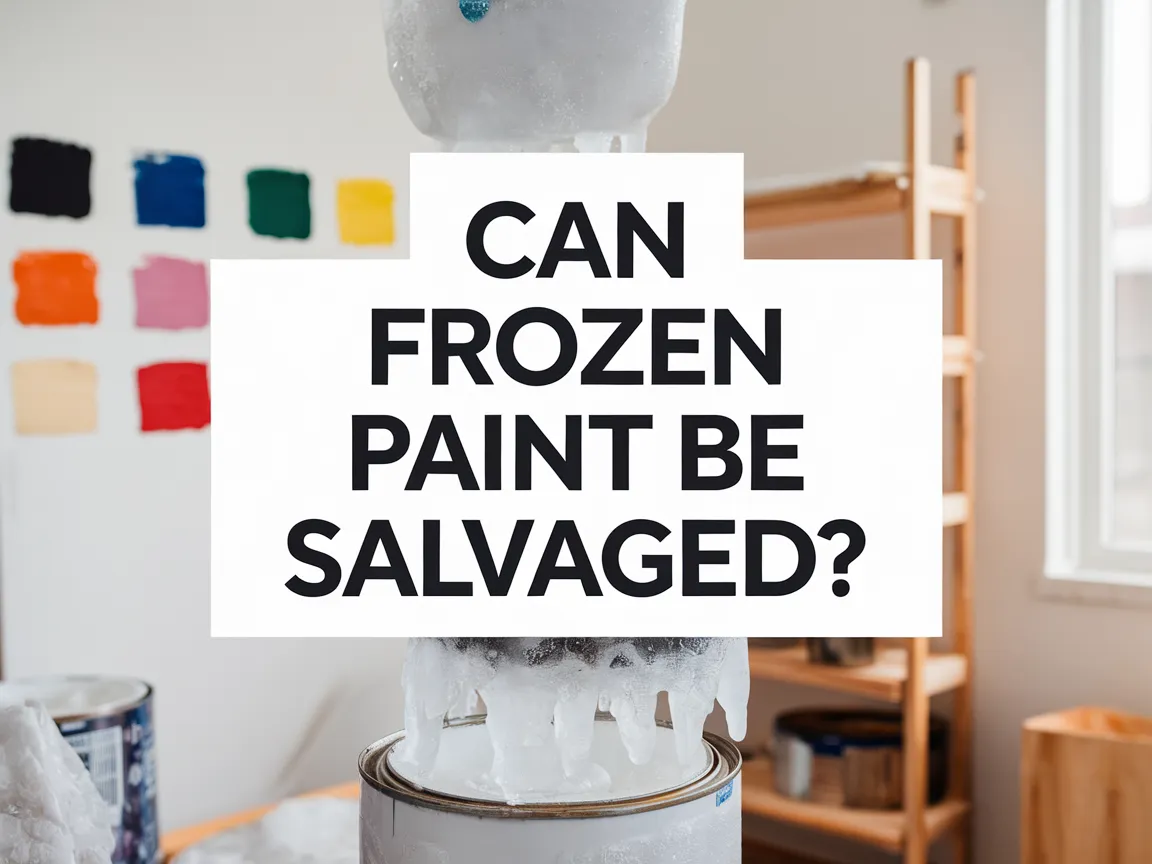How Cold Can Paint Be Stored?
Paint is a colorful liquid you spread on walls, furniture, or canvases to make things look beautiful. It’s like magic in a can that transforms everything!
So, how cold can paint be stored? It’s super important to store paint at the right temperature to keep it fresh and usable. I’ve seen what happens when paint freezes; it can become lumpy and unworkable, ruining your project.
In this guide, we’ll explore how to store paint properly, factors affecting paint storage conditions, common issues with the wrong temperature, and a few creative DIY ideas for using leftover paint. You’ll get all the details on how cold can paint be stored, plus tips to ensure your paint stays vibrant and ready for your next masterpiece.
Contents
- 1 How Cold Can Paint Be Stored?
- 2 What is Paint?
- 3 Essential Considerations Before Storing Paint
- 4 Step-by-step Guide to Properly Storing Paint
- 5 Types Of Paint and Their Storage Needs
- 6 Factors Affecting Paint Storage Conditions
- 7 Common Issues When Storing Paint at the Wrong Temperature
- 8 Impact of Low Temperatures on Different Paint Types
- 9 Temperature Fluctuations and Their Effects on Paint
- 10 Best Practices for Monitoring Storage Conditions
- 11 Common Paint Types and Their Optimal Storage Conditions
- 12 Signs of Paint Damage from Cold Storage
- 13 Finishing Touches for Proper Paint Storage
- 14 Frequently Asked Questions About Paint Storage
- 15 Conclusion
- 16 Additional Resources
How Cold Can Paint Be Stored?
Paint should ideally be stored between 50°F and 90°F (10°C and 32°C). Anything below 32°F (0°C) risks freezing, which can ruin it. Extreme cold affects consistency and application. If you’re wondering about painting techniques and storage, painting apartment walls properly requires careful temperature management. So, keep it cozy!
What is Paint?
Paint is a liquid mixture designed to coat surfaces. It typically contains pigments, binders, solvents, and additives. For example, about 55% of a typical paint volume is solvents (Like Water or Oil), while pigments account for 15% to 20% of the mixture. If you’re curious about applying paint to fabric, you might want to explore painting techniques for clothing.
Storing paint at the right temperature is crucial for its longevity. I once stored a batch in my basement during winter, and it wasn’t fun trying to use it when the temperature dropped!
I’ve seen a friend use paint for an outdoor mural project. He had to wait until the temperature reached a minimum of 10°C (50°F) before applying. This experience showed me how essential it is to store paint properly to maintain its quality and usability. When considering painting different surfaces like baseboard heaters, I recommend checking specific painting techniques for specialized heating equipment.
Essential Considerations Before Storing Paint
What do you need to prepare for?
- Temperature Gauge: Use a temperature gauge like the ThermoPro TP50 to maintain your storage area between 10°C and 30°C (50°F and 86°F) for optimal paint longevity.
- Container Sealer: A container sealer, such as 3M Foil Tape 3380, prevents air exposure that can ruin paint quality.
- Labeling System: Employ a labeling system like Brother P-touch to note paint types and dates. This helps track expiration, as unopened paint is best used within 2-10 years.
- Storage Shelf: You’ll need a sturdy storage shelf, ideally metal, to keep paint at least 30 cm (1 Ft) off the ground. This protects it from potential spills.
We covered important factors to consider before storing paint. We will now cover a detailed guide on how to store paint properly.
Also See: What is Auto Paint Correction? Enhance Your Car’s Finish

Step-by-step Guide to Properly Storing Paint
This guide covers how to store paint effectively in cold conditions.
-
Choose the Right Temperature
The ideal storage temperature for most paint is between 4°C and 32°C (40°F and 90°F). Storing paint outside this range can cause clumping, separation, or spoilage.
Avoid freezing paint, as temperatures below 0°C (32°F) can damage the chemicals. If it’s too cold, the paint might become inconsistent and ruin your future projects.
-
Keep Humidity Levels in Mind
Store paint in a cool, dry place with low humidity—ideally below 60%. High humidity can cause rust on can lids and spoil water-based paints.
A desiccant can help control moisture levels in particularly humid environments. This step greatly impacts paint longevity!
-
Seal Containers Properly
Ensure the lids on your paint cans are sealed tightly. Air exposure will dry out and ruin your paint, so pick an airtight option if available.
I’ve opened cans that seemed fine, but air seeped in and caused unwanted skin and dried patches. A proper seal saves you money and hassle!
-
Avoid Extreme Temperatures
Never store paint in a garage or shed that experiences extreme heat or cold. Both scorching and freezing temperatures can alter the chemical makeup of the paint.
If possible, find a climate-controlled area like a basement or closet. It’s worth avoiding separated compounds and compromised paint quality!
That covers how to properly store paint. Let’s now take a look at different types of paint and their storage needs.
Types Of Paint and Their Storage Needs
Let’s discuss the different types of paint: acrylic, oil, latex, and spray paint.
-
Acrylic Paint
Acrylic paint is water-based and dries quickly, usually in 15-30 minutes. Storing it below 10°C (50°F) can affect its consistency and cause separation.
-
Oil Paint
Oil paint takes much longer to dry, often taking days to weeks. High heat or extreme cold below 4°C (39°F) can thicken or spoil the oil, ruining your work.
-
Latex Paint
Latex paint is also water-based and known for its flexibility and durability. It’s best stored above 5°C (41°F); colder conditions can ruin its texture and quality.
-
Spray Paint
Spray paint is convenient for various applications, but it must be stored above 10°C (50°F). Temperatures below that can make the can unusable and affect paint quality.
This reminds me of a valuable lesson I learned with latex paint. I stored a can in my unheated garage, and the cold weather turned it into a chunky mess—definitely a mistake I won’t make again! If you’re curious about paint storage and paint maintenance techniques, I’ve learned a lot through trial and error.
We have now covered the various types of paint and their storage requirements. Next, we will discuss factors influencing paint storage conditions.
Factors Affecting Paint Storage Conditions
What factors impact the ideal cold storage temperature for paint?
-
Type of Paint: Different paints, like latex or oil-based, have varying storage requirements.
-
Temperature Fluctuations: Rapid temperature changes can spoil paint, regardless of the lowest storage temperature.
-
Humidity Levels: High humidity can lead to paint absorbing moisture, compromising its performance.
-
Sealed Containers: Unsealed or poorly sealed containers may cause paint deterioration at lower temperatures.
We covered the factors that influence paint storage conditions. We will now cover common issues that arise from improper temperature storage.

Common Issues When Storing Paint at the Wrong Temperature
Last winter, my friend tried to store his acrylic paint outside in freezing temperatures, around -10°C (14°F). It separated, ruining the texture and color.
To avoid this, keep paint above 4°C (40°F). For best results, store it in a climate-controlled area, maintaining a consistent temperature for durability and effectiveness.
Impact of Low Temperatures on Different Paint Types
Understanding how low temperatures affect various types of paint can help you store them properly.
| Type of Paint | Ideal Storage Temperature (°C) | Risks Below Freezing (°C) | Recommended Action |
|---|---|---|---|
| Acrylic Paint | 10°C (50°F) | Below 0°C (32°F) | Keep in a temperature-controlled area. |
| Oil Paint | 4-30°C (39-86°F) | Below 4°C (39°F) | Store away from extreme cold. |
| Latex Paint | 5-30°C (41-86°F) | Below 5°C (41°F) | Warm it up before use if stored too cold. |
| Spray Paint | 10-30°C (50-86°F) | Below 10°C (50°F) | Store indoors in a stable environment. |
Temperature Fluctuations and Their Effects on Paint
Understanding temperature fluctuations is key to preserving your paint’s quality.
- Rapid Changes: Paint can become damaged when exposed to sudden temperature drops. Try to maintain a steady climate.
- Room Temperature Impact: Storing paint in a room fluctuating between 50°F and 86°F (10°C and 30°C) is ideal. Avoid areas with extreme temperature swings.
- Seasonal Challenges: Winter and summer can have different impacts on paint. Monitor storage conditions based on the season.
Best Practices for Monitoring Storage Conditions
Keeping an eye on your paint storage conditions can prevent future issues.
-
Invest in a Thermometer
A reliable indoor thermometer keeps track of temperature. Opt for a digital one for easy reading.
-
Check Humidity Levels
Using a hygrometer can help you monitor humidity. Aim for levels below 60% to prevent moisture-related issues.
-
Regular Inspections
Inspect your paint cans monthly for signs of damage or change in texture. Early detection is crucial.
Common Paint Types and Their Optimal Storage Conditions
Here’s a quick look at how different paint types prefer to be stored.
| Type of Paint | Optimal Storage Temperature (°C) | Risks of Low Temperature | Best Storage Practices |
|---|---|---|---|
| Acrylic Paint | 10-30°C (50-86°F) | Thickening and separation | Keep in a temperature-regulated area. |
| Oil-Based Paint | 4-30°C (39-86°F) | Clumping and uneven texture | Store in stable conditions away from cold drafts. |
| Latex Paint | 5-30°C (41-86°F) | Loss of consistency | Ensure lids are sealed tightly. |
| Spray Paint | 10-30°C (50-86°F) | Pressure loss and performance issues | Keep indoors with consistent temperature. |
Signs of Paint Damage from Cold Storage
Detecting paint damage early saves time and money. Here are some signs your paint has suffered from too much cold.
- Lumpy Texture: If your paint feels gritty or has lumps, that’s a bad sign!
- Color Separation: If colors are visibly separating in the can, it’s often ruined.
- Strange Smell: Any unusual odor could indicate spoilage.
- Dried Surface: Check for a skin on top; this means air has gotten in.
Finishing Touches for Proper Paint Storage
To maintain paint quality, store it at temperatures above 32°F (0°C) to avoid freezing. Ensure lids are tightly sealed to prevent contamination.
Inspect your paint for signs of separation or lumps before use. A viscosity difference of 10 mPas indicates potential issues. I used Sherwin-Williams for consistent results.
I recommend using an infrared thermometer to monitor the temperature in your storage space, keeping the paint temperature stable at or above 50°F (10°C).
Frequently Asked Questions About Paint Storage
What Temperature is Too Cold for Paint?
Temperature is critical for paint storage, and too cold can affect the paint’s texture. Ideally, paint should be stored between 5°C to 30°C (40°F to 86°F). Lower temperatures can lead to separation and compromise its performance.
Can Paint Freeze and Still Be Used?
No, paint can’t typically freeze and still be used effectively. Freezing can cause ingredients to separate or clump, ruining the paint’s consistency and affecting its ability to adhere properly. If you’re curious about specific paint types and their unique properties, paint health considerations offer interesting insights.
What Should I Do if My Paint Has Thickened?
If your paint has thickened, you can try mixing it again to restore its consistency. Often, water or a bit of paint thinner can be added cautiously—typically about 10% of the total volume—to revive it without affecting quality. When working with specific materials like ABS plastic, you’ll want to ensure your paint application technique matches the surface requirements for optimal painting results.
How Long Can Paint Be Stored Before It Goes Bad?
Paint can be stored for 2 to 10 years, depending on the type and conditions. Water-based paints generally last about 10 years, while oil-based paints have a shorter shelf life, around 15 years if kept sealed and in optimal conditions. If you’re considering painting specific surfaces like aluminum-clad windows, painting aluminum window frames requires special preparation and techniques to ensure long-lasting results.
Can I Store Paint in the Garage?
Storing paint in the garage is often risky due to fluctuating temperatures. Paint to be stored there should ideally remain above freezing and below 30°C (86°F) to prevent degradation.
What Are the Signs That My Paint Has Gone Bad?
Signs that paint has gone bad include a foul smell, thick texture, or mold. If the paint smells rancid, and you see lumps or clumping, it’s time to dispose of it properly.
Is It Important to Keep Paint Cans Sealed?
Yes, keeping paint cans sealed is crucial. A tightly closed can prevents air from entering, protecting the paint from thickening or drying out, which can occur within a few months if left open. If you’re working on a painting project that involves specialized surfaces like painting alloy rims with precision, proper paint storage becomes even more critical.
Should Paint Be Stored Upright or on Its Side?
Paint should always be stored upright. This position minimizes potential leaking and preserves cap integrity to keep moisture out, ensuring longer shelf life.
Also See: Can Ash Damage Car Paint? How to Protect Your Vehicle
Conclusion
We’ve covered a lot about how cold paint can be stored, including key insights into paint types, essential storage considerations, a step-by-step guide, and factors affecting storage conditions.
I trust these insights have been helpful in understanding that paint can usually be stored at temperatures above freezing, ideally between 32°F (0°C) and 75°F (24°C) to maintain its quality and usability.
As you wrap up, consider exploring more resources on this topic at Paint Answers.
Additional Resources
- Gurney, J. (2009). Color and Light: A Guide for the Realist Painter. Kansas City, MO: Andrews McMeel Publishing.
Experienced interior designer with 15+ years in transforming spaces, blending artistry with expertise in color and design. Rhode Island School of Design graduate, specializing in restorations and modern makeovers.
Health, Misc.




